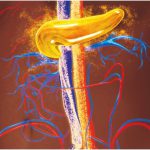Liver – a vital organ
The liver is the largest solid organ in the human body. It carries out over 500 essential functions. In simpler terms, its functions can be divided into three domains:Detoxification – The liver is strategically placed between the blood coming from intestines, carrying all the nutrients and toxins that we ingest and produce in intestines, and the systemic circulation (the main blood stream in the body). So, it checks out all the things coming from intestines before it is poured into the systemic circulation. It eliminates many toxins and acts as an important detoxifying machine. It converts poisonous ammonia (produced in body) to urea which is excreted in the urine.Synthesis – The liver is the main site for metabolism of carbohydrates, proteins and lipids. It produces glucose, amino acids and fatty acids when need arises. The liver also produces variety of substances required for coagulation process (the process by which bleeding stops). It also produces and secretes bile into the intestines that carries away modified toxins from the liver. Bile then helps in absorption of fats in the intestines.Storage – The liver stores glycogen (chains of glucose) in times of energy excess and releases glucose into the blood in times of energy deficient. It also stores fat-soluble vitamins, such as vitamins A, D, E and K.
Types of fatty liver disease and its complications
Liver is the key organ for metabolism. In the liver, free fatty acid is at the centre of fatty liver disease. The liver can accumulate fat if you consume excess alcohol. In that case, it is called alcoholic fatty liver disease. When the liver accumulates fat because of overweight/obesity, in the absence of significant alcohol consumption, it is called non-alcoholic fatty liver disease (NAFLD).
For our discussion, we will discuss the second one, as it is the most common type. In NAFLD, the liver receives free fatty acids from two sources. First from the stored depots of body fat, as in the presence of insulin resistance, enough free fatty acids are released into the blood stream. Second source is from the carbohydrates that we consume. The liver converts excess glucose and fructose into fatty acids. Now in the presence of long-term over-nutrition and under-activity, free fatty acid pool in the liver expands. The liver has three mechanisms to dispose of these fatty acids. One way is to use it for energy production, called beta oxidation. Another way is to convert it into triglycerides and put it into VLDL and through it back into blood. Yet another way is to store these triglycerides as lipid droplets in the liver cells. This is the fat that we see on ultrasound or biopsy. When the fatty acid load is high enough to overwhelm these mechanisms, reactive lipid species are formed. These toxic species cause inflammation in the liver, causing the benign fatty liver to progress to
Non-alcoholic steatohepatitis (NASH).
When the influx of free fatty acids remains unabated, and repairing mechanisms are overwhelmed, hepatic stellate cells are activated that produce scarring of liver (fibrosis). It is this stage of NAFLD that is high risk for liver cirrhosis and cardiovascular disease (heart attack and stroke). But the good news is that even till the fibrosis stage, if the free fatty acid load is reduced, the condition is reversible. In case of continued influx of free fatty acid and consequent inflammation, cirrhosis develops. In a few individuals, it can even progress to liver cancer.
Symptoms of fatty liver disease
In most of the individuals, fatty liver disease remains silent. This is the real problem as you can carry fatty liver for years without knowing it. Some individuals feel heaviness below right side of ribcage. Some people with fatty liver feels fatigued.
Non-alcoholic fatty liver and Diabetes
Long-term over-nutrition and under-activity leads to fat deposition in the organs such as muscle, liver, pancreas which are not normal places for fat deposition. This gives rise to a condition known as insulin resistance, where insulin function is impaired. It is this insulin resistance that is the mother of most of the lifestyle diseases, such as Type 2 Diabetes, cholesterol issues, as well as fatty liver disease. This is the reason why Diabetes and fatty liver disease go hand in hand. It is not only their association, but presence of Diabetes worsens NAFLD in all the stages. Without Type 2 Diabetes, the incidence of NAFLD is 20-25 per cent in general population, but in people with Diabetes, the incidence is as high as 70-80 per cent.
Insulin resistance causes fat in the body fat depots to breakdown into free fatty acids, and thereby increase the blood free fatty acid levels. These fatty acids in the liver initiate the processes of NAFLD. This is what typically occurs in Type 2 Diabetes.
However, fatty liver can also occur in people with Type 1 Diabetes. Over time, some people with Type 1 Diabetes accumulate body fat, develop insulin resistance that
 n
n
worsens their glucose control as well as gives rise to NAFLD. However, the incidence is less than people with Type 2 Diabetes.
Fatty liver occur in children
The prevalence of obesity as well as fatty liver disease is increasing in children. In a study from our country, 22.4 per cent school children had fatty liver on ultrasound; 18.9 per cent in normal-weight and 45.6 per cent in overweight/obese category.
High sugar levels and fatty liver disease
High sugar levels in the blood are taken up by the liver. In the liver, high sugar is a raw material for fatty acid production. As the sugar level goes high, fatty acid levels go high that lead to the development as well as worsening of NAFLD.
Testing for fatty liver disease
Ultrasound is often a good screening test for detection of fat in liver. However, its utility is doubtful in the management of people with NAFLD, as ultrasound does not tell anything about inflammation and fibrosis of liver, which are the stages of NAFLD that usually progress to liver cirrhosis. Liver enzymes (SGOT and SGPT) are also not useful, as most people with advanced NAFLD have normal liver enzymes.
Itmustbenotedthatamongallpeoplewith fatty liver, only 10-15 per cent people progress over time and develop liver complications. In the remainder, fatty liver remainsabenigndisease.However,thereal question is how to identify those 10-15 per
 n
n
cent people who are likely to progress. One approach is to identify those who have developed liver fibrosis, as these people are more likely to develop cirrhosis of liver.
Various scoring systems have been developed, using common parameters that help identifying those people who are at high risk for complication development.
One such score is called fibrosis-4 score, which uses four parameters, namely, age, SGOT, SGPT and platelet count. By using an online calculator, you can calculate a score, that if less than 1.45, tells that the patient has low risk for liver fibrosis.
Another test that tells you about fibrosis of liver is called fibro scan. It gives a liver stiffness score that when more than 7.0 kPa, is a high risk for liver fibrosis.
By far, the best non-invasive tests for fat and fibrosis in liver are MRI-based fat estimation and elastography respectively. It gives an accurate measurement of liver fat and fibrosis. The gold standard for estimating fat, inflammation and fibrosis in liver is still liver biopsy, but it is usually not preferred as it is invasive and carries some risk.
Diet for fatty liver disease and Diabetes
Dietary recommendations for fatty liver disease and Diabetes are similar, as both diseases arise from the same process. Life- style modification (diet and exercise) is the best strategy for many life-style diseases that stem from over-nutrition and
under-activity. A healthy lifestyle can prevent and even resolve fatty liver disease.
A healthy lifestyle consists of two components-physical activity and dietary pattern. Healthy dietary pattern means consuming a balanced diet. A diet that is high in fibre and low in refined carbohydrates and fats. Avoid fast and junk foods like sugary beverages, fruit juices, ice- creams, deep fried foods, chips and pizzas. Cut back on refined carbohydrates like white bread, white rice, white pasta and potatoes. Consume diet that is rich in fruits, vegetables, beans, whole grains, nuts and seeds. Reduce consumption of red meat and instead use chicken and fish.
Medications for fatty liver disease
There are no FDA approved medicines for fatty liver disease. However, for people who have coexisting Diabetes and fatty liver, some Diabetes medicines can help, such as pioglitazone, SGLT-2 inhibitors and GLP-1 receptor agonists.
Exercises for fatty liver disease
Regular physical activity is a part of healthy lifestyle. Activities like brisk walk, jogging, cycling, etc., helps in maintaining normal weight. Exercise is beneficial to metabolic health independent of weight loss. That means if you are obese and you exercise regularly, even if you do not lose weight, you still are benefiting your body.
To conclude
Like Type 2 Diabetes, obesity and cholesterol issues, fatty liver disease is a lifestyle disease. Therefore, the best strategy is to prevent these diseases by maintaining a normal body weight. Of course, in this obesogenic environment, maintaining normal body weight requires efforts, but it is worth it.
 n
n














